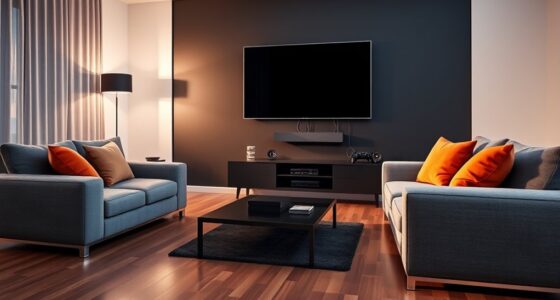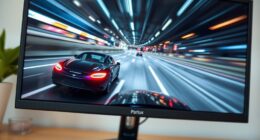Stop guessing about input lag by learning how it impacts your gameplay and taking control of your setup. Use tool-based testing with calibration software to find where delays happen and adjust your monitor’s refresh rate, disable unnecessary features, and enable game mode for faster response times. Choose wired peripherals and optimize your environment for minimal interference. Keep these tips in mind, and you’ll discover the precise steps to truly improve your gaming performance.
Key Takeaways
- Use calibration tools like UFO Test or Leo Bodnar to accurately measure and verify your input lag.
- Enable game mode, disable motion smoothing, and set your monitor to the highest refresh rate supported.
- Opt for wired peripherals and Ethernet connections to minimize latency and signal interference.
- Position your monitor and peripherals ergonomically to reduce strain and improve reaction times.
- Regularly update display firmware and software to optimize input handling and responsiveness.
Understanding Input Lag and Its Impact on Gameplay

Understanding input lag is vital because it directly affects how responsive your gameplay feels. When your controller isn’t properly calibrated, your inputs may register with delays, making your actions less precise. Regularly checking and adjusting controller calibration ensures your commands are accurately relayed to the game, reducing perceived lag. Additionally, keeping your gaming software and system firmware up to date is important, as developers often release updates that optimize input handling and minimize delays. Outdated software can introduce unnecessary lag, impacting your response time and overall experience. Ensuring that your gaming environment has good air quality can also help maintain focus and reduce lag caused by hardware overheating or performance issues. By maintaining proper controller calibration and staying current with software updates, you can considerably cut down input lag, making your gameplay smoother and more responsive. These steps form the foundation for a more responsive gaming setup.
Identifying Common Sources of Input Delay
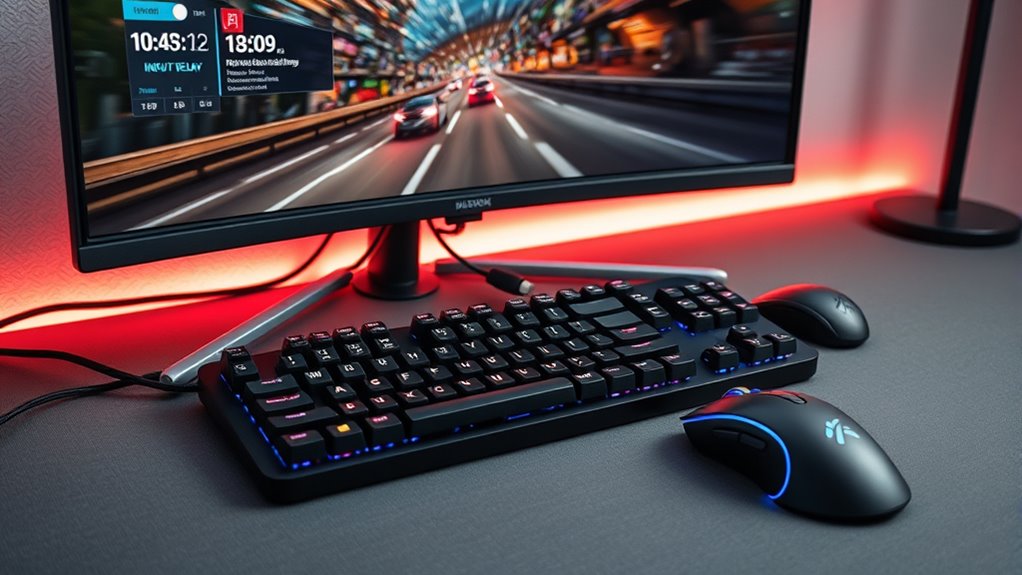
To effectively address input delay, you need to identify its common sources within your gaming setup. First, consider visual delay, which occurs when your display’s refresh rate or processing time causes lag between your actions and what you see. Second, controller latency can add noticeable input delay, especially with wireless controllers or those with high polling rates. Third, your gaming hardware, including consoles and PCs, might introduce delays through slow processing or outdated components. Additionally, selecting a Home Theatre Projector with low input lag is crucial for responsive gameplay. By pinpointing these sources, you can better understand where the delay originates. Reducing visual delay involves choosing a faster display, while lowering controller latency might mean switching to wired controllers. Addressing hardware issues ensures your setup runs smoothly, minimizing input delay and giving you a competitive edge.
Optimizing Your Display and Hardware Settings
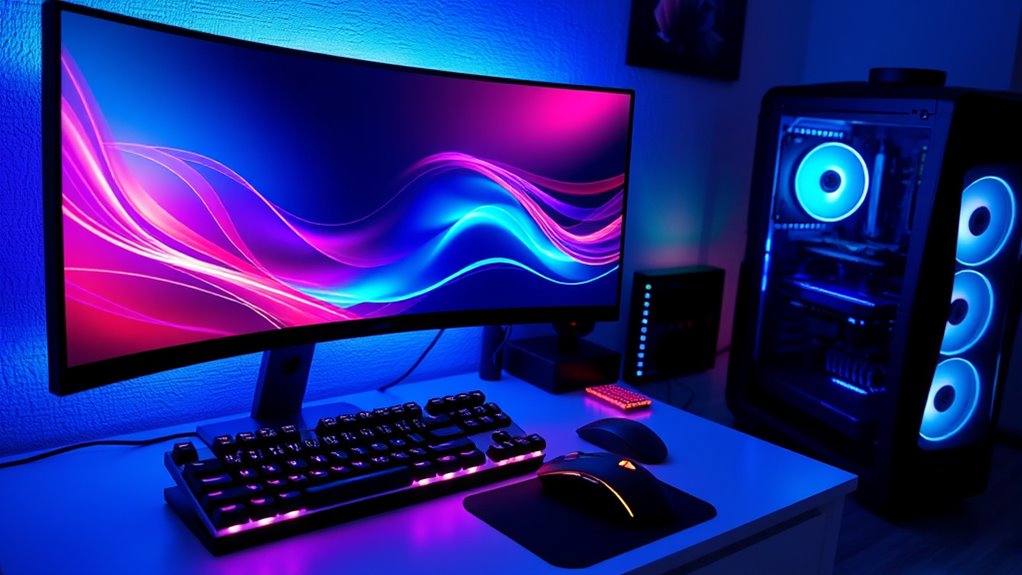
Optimizing your display and hardware settings is essential for reducing input lag and enhancing your gaming experience. Begin with calibration techniques to ensure your monitor displays colors accurately and response times are minimized. Adjust the refresh rate to the highest your display supports, as higher rates lower input lag. Pay attention to ergonomic considerations, positioning your monitor at eye level and maintaining a comfortable viewing distance to reduce eye strain and improve reaction times. Disable any unnecessary image processing features like motion smoothing or sharpening, which can add latency. Use game mode or a similar setting on your display for optimized performance. These adjustments help create a more responsive setup, giving you a competitive edge and a smoother gaming experience overall. Incorporating proper hardware configuration ensures your system operates efficiently and supports low input lag.
Choosing the Right Peripherals for Minimal Latency
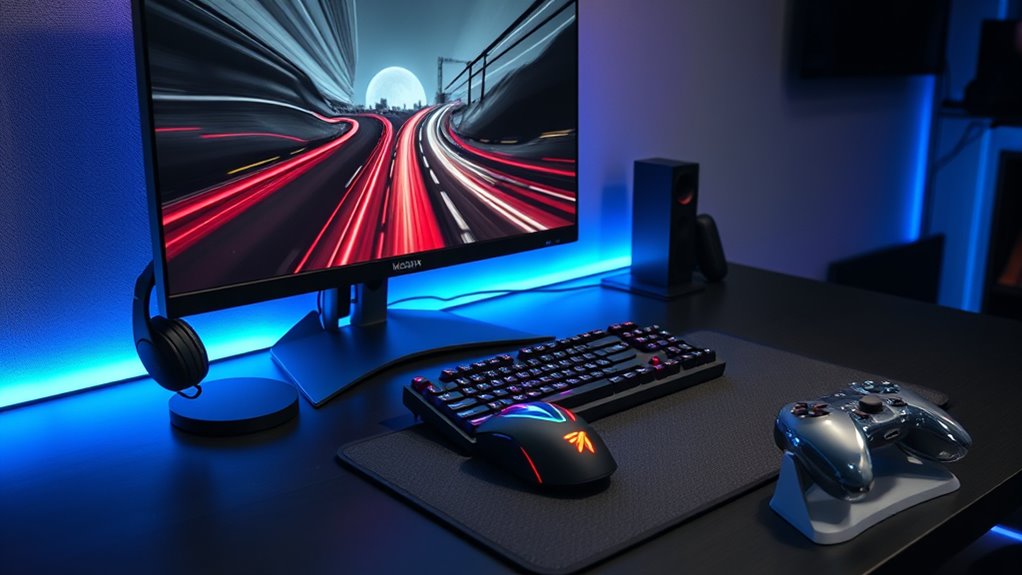
To minimize input lag, you need to choose peripherals that prioritize speed and responsiveness. Wired devices typically offer lower latency than wireless ones, ensuring your actions register faster. Additionally, selecting high-refresh-rate monitors and compatible peripherals can give you a smoother, more responsive gaming experience. For those interested in customizing their setup, exploring performance tuning options for peripherals can further optimize responsiveness and overall gaming performance.
Select Low-Latency Devices
Choosing the right peripherals can substantially reduce input lag and enhance your gaming experience. To do this, focus on low-latency devices that respond quickly and accurately.
- Choose gaming mice with high polling rates and low click delay to ensure fast response times.
- Select a monitor that supports low input lag and proper calibration for accurate visuals.
- Regularly calibrate your monitor to eliminate delays caused by incorrect color or brightness settings, which can affect your reaction time.
- Consider security features in your setup to protect your gaming system from cyber threats and unauthorized access.
Opt for Wired Connections
Wired connections offer a direct and dependable link between your peripherals and your gaming setup, minimizing the chances of signal interference that can cause input lag. Wireless interference from other devices or crowded frequencies can disrupt signals, leading to inconsistent performance. Bluetooth latency, in particular, can add noticeable delay between your actions and what appears on-screen, reducing your responsiveness. By choosing wired peripherals like a USB mouse or keyboard, you eliminate these issues entirely. Wired connections provide consistent data transfer speeds, ensuring your commands register instantly. This reliability is essential for fast-paced gaming where every millisecond counts. Investing in wired devices helps you maintain ideal input latency, giving you a competitive edge and a smoother, more responsive gaming experience. Additionally, using a dedicated gaming setup can further optimize your performance by minimizing environmental distractions and ensuring all components work harmoniously.
Prioritize High Refresh Rate
Opting for peripherals with high refresh rates can substantially reduce input lag, giving you a smoother and more responsive gaming experience. The refresh rate importance becomes clear when you realize that higher rates, like 144Hz or 240Hz, translate to more updates per second, lowering delay. To guarantee optimal performance, consider these factors:
- Check hardware compatibility to confirm your monitor, mouse, and keyboard support high refresh rates.
- Select a monitor with at least 144Hz to maximize refresh rate benefits.
- Use peripherals designed for low latency, ensuring they can handle the high refresh rates without lag.
Matching your peripherals with your hardware setup guarantees minimal input lag and smooth gameplay, making high refresh rate peripherals an essential investment.
Practical Steps to Test and Reduce Input Lag
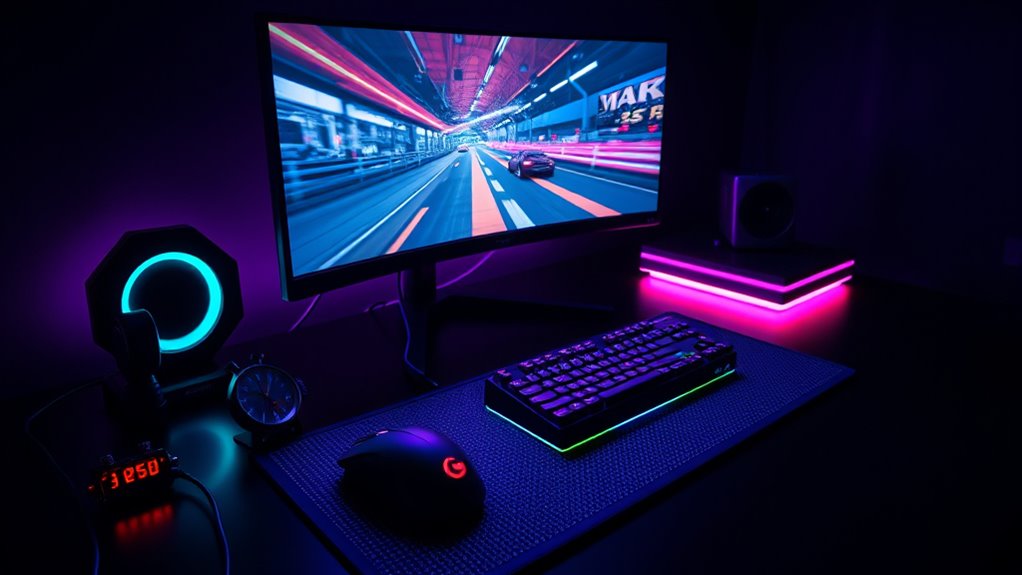
To improve your gaming experience, start by measuring your input lag with reliable tools to identify issues. Then, adjust your display settings to minimize delay and guarantee your connection is stable and fast. Taking these practical steps can make a noticeable difference in your gameplay responsiveness. Additionally, staying informed about cybersecurity threats ensures your gaming setup remains secure from evolving risks.
Measure With Tools
Measuring input lag accurately is essential for identifying and reducing delays in your gaming setup. Using proper calibration techniques and reliable software tools helps you get precise readings. Here’s how to proceed:
- Choose a calibration technique, such as using a high-speed camera or specialized input lag testers, to ensure accurate measurements.
- Use software tools designed for input lag testing, like UFO Test or Leo Bodnar’s Input Lag Tester, to analyze response times effectively.
- Conduct multiple tests to verify consistency, then compare your results against manufacturer specs to identify potential issues.
- Understanding display technology and how it affects input lag can help you select the best equipment for your gaming needs.
Adjust Display Settings
Adjusting your display settings can considerably reduce input lag and improve your gaming experience. Start with display calibration to ensure your monitor shows accurate images, which helps you react faster. Disable any unnecessary image processing features like motion smoothing or post-processing effects, as these can introduce lag. Set your monitor’s refresh rate to the highest supported for smoother visuals. Enable game mode if available; it’s designed to optimize input response. Pay attention to color accuracy, as proper calibration guarantees consistent visuals, preventing delays caused by inaccurate color rendering. Adjust brightness and contrast for clarity without overprocessing. Additionally, understanding regional legal resources can help if you need professional assistance with hardware issues or disputes. These steps help you minimize lag directly linked to your display, giving you more precise control and a more responsive gaming environment.
Optimize Connection Quality
Since a stable, high-quality connection is essential for minimal input lag, you should regularly test your network performance and prioritize your gaming device’s connection. To optimize connection quality, focus on improving wireless connectivity and maximizing network bandwidth. Here are three practical steps:
- Use a wired Ethernet connection instead of Wi-Fi whenever possible to reduce latency and avoid interference.
- Run speed tests to check your network bandwidth, ensuring it’s sufficient for gaming without lag spikes.
- If using Wi-Fi, position your router closer to your gaming device and minimize obstacles to boost signal strength.
Implementing a Personalized Gaming Setup for Peak Performance
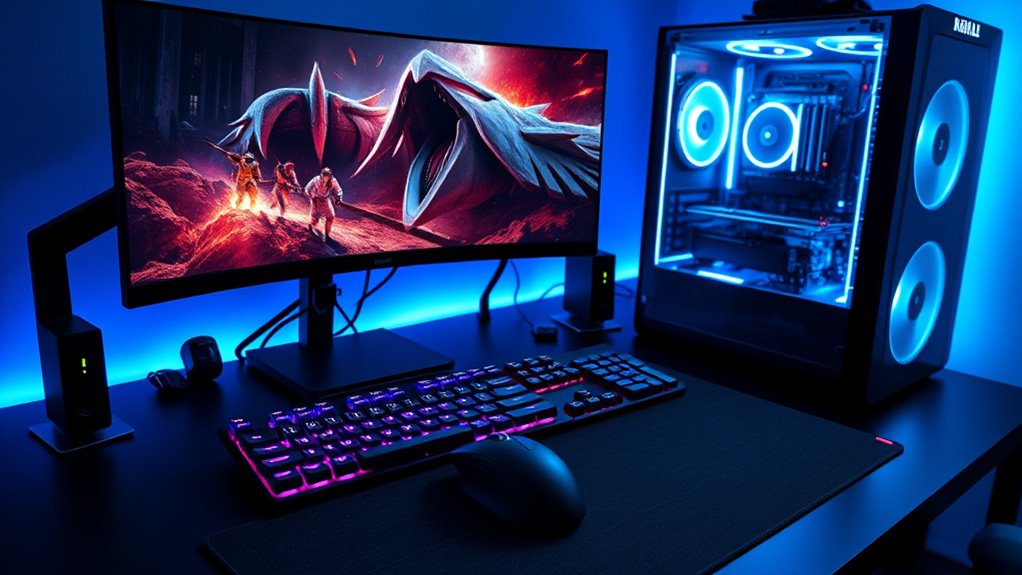
Creating a personalized gaming setup is essential for achieving peak performance, as it allows you to optimize comfort, reduce input lag, and enhance overall responsiveness. Focus on controller ergonomics to guarantee your hands stay comfortable during long sessions, which helps prevent fatigue and improves control accuracy. Adjust ambient lighting to create an environment that minimizes glare and distractions, allowing you to concentrate fully on the game. Proper positioning of your monitor and peripherals can also make a significant difference, reducing strain and improving reaction times. Tailoring your setup to your preferences not only boosts comfort but also sharpens your gameplay. Remember, a well-optimized space makes a noticeable difference in your ability to respond quickly and consistently. Additionally, digital literacy can help you stay informed about the latest gaming technology and setup tips, further enhancing your gaming experience.
Frequently Asked Questions
How Does Internet Latency Affect Overall Gaming Responsiveness?
Internet latency directly impacts your gaming responsiveness by affecting how quickly your actions register and how fast you receive game updates. When your internet speed is high but ping fluctuates, you experience delays that hinder your reaction time. Consistent ping is vital for smooth gameplay. If ping spikes occur often, you’ll notice lag, making it harder to respond accurately and enjoy a seamless gaming experience.
Can Overclocking Hardware Reduce Input Lag Effectively?
Think of overclocking as revving your engine to accelerate faster; it can reduce input lag by boosting your hardware’s performance. To keep this speed safe, guarantee proper hardware cooling and a reliable power supply, preventing overheating and voltage drops. When done right, overclocking sharpens your responsiveness, making your gaming feel more immediate. Just remember, pushing too hard might cause instability, so balance it carefully for the best results.
What Role Does Room Lighting Play in Screen Response Times?
Room lighting impacts screen response times by influencing your perception of input lag. Ambient illumination can reduce eye strain and improve visibility, but excessive glare causes reflections that hinder your response. To optimize your gaming setup, aim for balanced lighting that minimizes glare and enhances contrast, helping you see details clearly and react faster. Proper lighting creates a comfortable environment, ensuring you stay focused and connected to your gameplay.
Are There Specific Game Genres More Sensitive to Input Lag?
Ever noticed how some games feel more demanding on your reflexes? Certain game genres, like FPS or fighting games, are highly sensitive to input lag impact. These fast-paced titles require split-second reactions, making even slight delays noticeable and frustrating. If you’re into competitive gaming, you’ll want to minimize input lag to stay sharp. Your setup matters—every millisecond counts when precision can mean the difference between victory and defeat.
How Often Should I Update My Gaming Peripherals for Optimal Performance?
You should update your gaming peripherals every 1-2 years to guarantee peak performance. Regular peripheral maintenance, like cleaning and firmware updates, keeps your gear in top shape. Keep an eye on hardware upgrades when you notice lag or responsiveness issues, as newer peripherals often feature better technology. Staying proactive with these updates helps reduce input lag, enhances your gaming experience, and keeps your setup competitive.
Conclusion
Now that you know how to tackle input lag, you’re ready to elevate your gaming. With each tweak and test, you’re not just reducing delay—you’re sharpening your edge. Remember, every millisecond counts, and your setup is the secret weapon. So, take control, fine-tune with purpose, and turn your gaming space into a fortress of speed. Because in the race against delay, it’s your readiness that makes all the difference.




